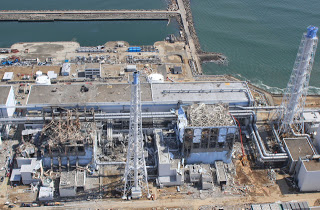Guest Post by Chris Phoenix, co-founder of the Center for Responsible Nanotechnology
Three of the buildings at the Fukushima Daiichi nuclear power plant have been destroyed. Two of them contained damaged, overheated nuclear reactors which were probably producing large quantities of hydrogen gas, so it’s not surprising that they blew up. But the third building to explode – building 4 – had no nuclear fuel in its reactor.
The cause of its demise was listed as a hydrogen explosion, but it’s become apparent that its fuel pool never went dry, so there would not have been a source of hydrogen. So what made it blow up?
A little arithmetic provides a plausible, but surprising, answer. It turns out that a massive amount of energy can be stored in hot water under modest pressure – and a forty-foot-deep pool provides sufficient pressure.
Water at the bottom of the pool would be under about 2 atm of pressure, and would boil at about 125 C. Water stores 4 joules (watt-seconds) per gram per degree celsius. There are a million grams in a metric ton (cubic meter). Multiply it out, and you get 100 million watt-seconds (about 28 kWh) per cubic meter. In terms of explosives, that’s the energy released by 24 kg (53 lbs) of TNT.
Normally, the heat from the fuel rods would be transferred to the bulk of the pool water by convection. But after a 9.0 earthquake, it’s easy to imagine things that could block convection:
1) A fuel rack tips over
2) Something flat falls into the pool and covers the top of the rack (hot water is not very buoyant, so would not force its way past)
3) A rack falls off its supports and rests on the pool bottom, closing the bottom of its tubes
Now we get to the explosive part. Suppose you have several cubic meters of water trapped in a fuel rack. If the pressure were reduced, that water would generate a lot of steam. In fact, if the pressure were reduced to 1 atm, each cubic meter of 125 C water would generate about 44 kg or 75 cubic meters of steam.
Once the water reaches boiling point, it might bubble quietly. But if it were disturbed, or started to convect to the surface, it might produce a significant amount of steam all at once. Once a quantity of water flashes to steam and displaces the pool water, the pressure will be reduced, and more water will flash to steam. This is exactly how a geyser works. However much hot water is trapped in the pool, that’s how much steam you will get, very rapidly. The geyser will tend to go straight up through the water, so if only one area of the pool floor were involved, most of the water might be left in the pool (which matches observations).
Even if only a fraction of the fuel racks were involved, we could still be talking hundreds of cubic meters of trapped hot water. The explosive force could be equivalent to tons of TNT, and the volume of steam could be comparable to the volume of the building. (The fuel racks are about 4 meters high. 4x5x5 meters of hot water equals a 20-meter (60 foot) cube of steam.)
This type of explosion would defy most of our intuitions about explosions and their effects on structures. Compared to chemical explosions, the pressure produced would be very low, and the volume of gas would be very high. The atmosphere would act as a tamper, keeping the water pressurized for perhaps large fractions of a second – perhaps long enough to force still-pressurized water into lower levels of the building, where it might still have enough heat (pressure) to blow out the walls.
One thing I have wondered about is what kind of explosion could blow out walls below the level of the fuel pool, while not even blowing off all the panels near the roof. An explosive (hot water) that can be transported several meters, and flow through cracks and around corners, before it finishes exploding (expanding), might answer this puzzle.
In hindsight, and after doing the arithmetic, it seems clear that cataclysmic steam geysers could occur in a spent fuel pool where convection was blocked. But it may not have been realized until now. It took me a week to think of it, and another week to convince even some of the people at the Physics Forum thread * where I have been discussing it. If steam geysers are, in fact, an unrecognized failure mode of spent fuel pools (and the buildings that contain them!) then it has implications both for the Fukushima cleanup and for the overall risk-assessment process of nuclear power plants.
* The Physics Forum thread contains thousands of posts. Use this link to find mine. The discussion of this hypothesis starts on p. 245 of the thread.
If you liked this article, please give it a quick review on ycombinator or StumbleUpon. Thanks

Brian Wang is a Futurist Thought Leader and a popular Science blogger with 1 million readers per month. His blog Nextbigfuture.com is ranked #1 Science News Blog. It covers many disruptive technology and trends including Space, Robotics, Artificial Intelligence, Medicine, Anti-aging Biotechnology, and Nanotechnology.
Known for identifying cutting edge technologies, he is currently a Co-Founder of a startup and fundraiser for high potential early-stage companies. He is the Head of Research for Allocations for deep technology investments and an Angel Investor at Space Angels.
A frequent speaker at corporations, he has been a TEDx speaker, a Singularity University speaker and guest at numerous interviews for radio and podcasts. He is open to public speaking and advising engagements.


